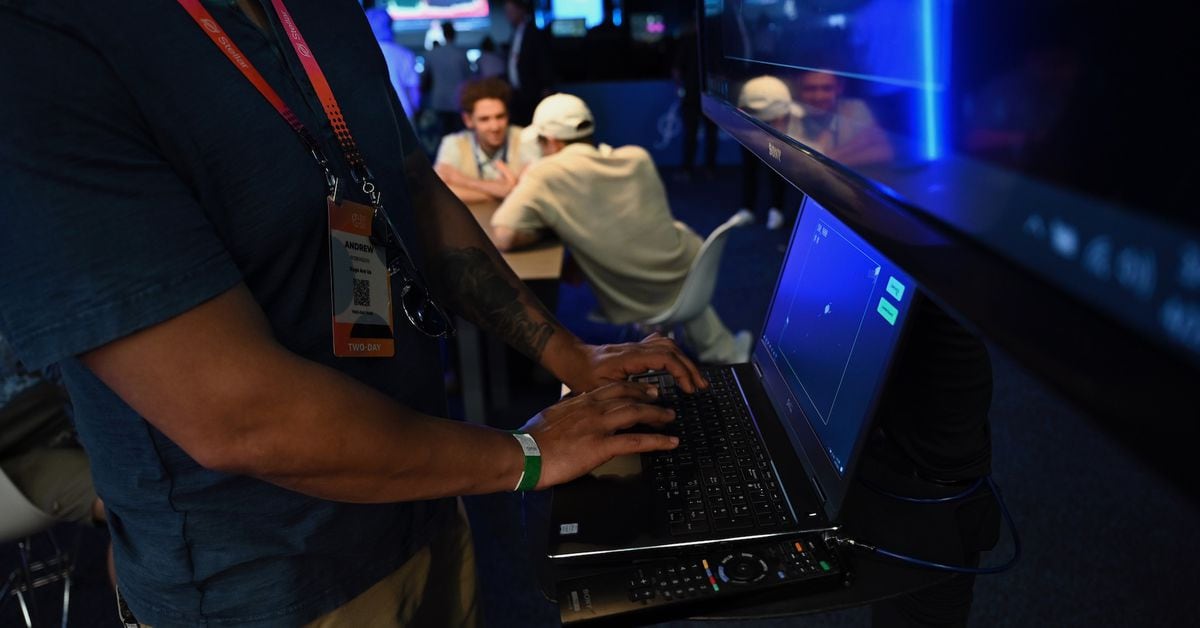Blockchain
Oobit’s collaboration with TON allows users to spend Tether sent via Telegram

May 17: Oobita mobile payment app, has “partnered with the TON Foundation to integrate its native cryptocurrency, TON (Toncoin), in its platform, promoting the use of cryptocurrency as a means of payment,” according to the team: “Toncoin holders will be able to Tap & Pay at over 100 million retailers worldwide. The integration will further strengthen the recent announcement of the collaboration between the largest company in the digital asset sector, Tether, and the TON Foundation.” According to a separate press release on Tether’s website: Users will be able to “send USDT as a direct message on Telegram and spend the same USDT for instant Tap cryptocurrency payments on Oobit.”
Radix update “Bottlenose” introduces “AccountLockers” for routing tokens
May 17: Radixplatform for DeFi and Web3, he “proposed a Bottlenose dolphin protocol update to its node runner community and is expected to go live around June 3rd. One of the highlight features of the update is the introduction of AccountLockers, a “locker” into which token deliveries are routed, which can be accepted or rejected. AccountLockers are intended to block unwanted deposits and simplify dApp accounting. Other Bottlenose features include API and Radix Engine improvements and the addition of a recovery fee vault, eliminating the need to lock third-party fees during account recovery.”
Internet-based “Bitfinity EVM” launches as Bitcoin L2 and supports runes
May 17: Bitcoin level 2 Bitfinity has introduced its Ethereum Virtual Machine (EVM) to port smart contracts Bitcoin protocols and leverage runes to enable Bitcoin DeFi apps. Based on the Internet Computer Protocol (ICP), Bitfinity integrates with the Bitcoin network and allows the connection of assets to other blockchains. The Internet Computer technology stack will allow applications using Solidity, Ethereum’s smart contract programming language, to access Bitcoin-based tokens.
Mintlayer, Salus partners on the layer 3 “Thunder network” connected to Bitcoin
May 17: Layer-2 scaling solution Mentaio and Salus, a security company specializing in zero-knowledge (ZK) technology, are collaborating to improve Bitcoin through the creation of Thunder Network, a solution based on layer 3 ZK rollups, according to the team. “The Thunder Network is designed to address any scaling issues the Mintlayer Network may encounter, while enabling additional EVM functionality that may currently be absent from Mintlayer,” according to a Press release.
DroppGroup Announces “DroppLink” to Tokenize Gen AI Outputs
May 17: Drop Group, with the aim of harmonizing artificial intelligence and blockchain technology, has “announced the launch of droppLink, an intelligent services platform poised to transform the development and management of artificial intelligence across multiple blockchains. The architecture of DroppLink abstracts computational requirements, facilitates micropayments, and democratizes data contribution, providing users with ownership and control, all while stakeholders, known as Computational Resource Patrons (CRPs), bear the costs of infrastructure and share in the revenue generated from the artificial intelligence processes they enable.” According to the project website, “end-user Gen AI outputs are tokenized as unique digital assets on the Solana blockchain and are stored on the Filecoin network.”
Diagram illustrating droppLink in a setup with Solana and Filecoin (droppLink)
Union and Stargaze to enable the transfer of “Ethereum Blue-Chip NFTs” to Cosmos
May 17: Unionthe modular interoperability layer, is “collaborating with Stargaze, a community-owned decentralized NFT marketplace, to enable the transfer of blue-chip Ethereum NFTs to the Cosmos ecosystem via its trustless and decentralized zkIBC bridge. This collaboration paves the way for the Achieving Trustless Interoperability for NFTs,” according to the team.
Oracle Project Pyth Launches $22 Million Ecosystem Grant Program
May 17: Pitoa blockchain oracle project, is “launching their Ecosystem Grants Program with 50 million PYTH (worth approximately $22 million at today’s prices) dedicated to this activation,” according to the team: “The program seeks projects focused on at least one of these three key areas: community grants, research and developers”.
DTCC, Chainlink Pilot accelerates fund tokenization with JPMorgan, Templeton, BNY Mellon
May 17: on Depositary Trust and Clearing Corporation (DTCC)the largest securities settlement system in the world, completed a pilot project with blockchain oracle Chain shirt (CONNECTION) and several major U.S. financial institutions, with the goal of helping accelerate the tokenization of funds, according to a relationship published by the DTCC. The purpose of the project called Intelligent NAV was to establish a standardized process for porting and disseminating funds’ net asset value (NAV) data to virtually any private or public blockchain using Chainlink CCIP interoperability protocol. Market participants included American Century Investments, BNY Mellon, Edward Jones, Franklin Templeton, Invesco, JPMorgan, MFS Investment Management, Mid Atlantic Trust, State Street and US Bank. (CONNECTION)
Diagram illustrating the “Smart NAV” pilot project (DTCC)
EasyA Consensus Hackathon – Invitation to participants
This year, Consensus will host its first in-person hackathon alongside the world’s #1 Web3 learning app, EasyA. It will be a three-day, multi-chain IRL hackathon with world-class sponsors, from Sui to Stellar to Polkadot and beyond, and will attract the world’s best developers to build the future of Web3 and raise funds for their projects.
Projects launched by EasyA alumni are worth over $2.5 billion. The EasyA Consensus hackathon will be the biggest hackathon of 2024 so far.
We still have a few spots open for hackers, so if you’re excited to attend, be sure to do so sign up here!
FLock.io will combine decentralized AI training with Morpheus’ “intelligent agents.”
May 16: FLock.ioa platform for “AI co-creation,” and Morpheus, a network to power intelligent agentsannounced a strategic partnership “to advance decentralized AI capabilities in Web3,” according to the team: “By bringing together FLock.ioof the decentralized, community-driven AI training model platform with Morpheus, which allows Smart Agent builders to deploy their code and receive rewards, the partners aim to reduce reliance on centralized external function calls to OpenAI and integrate more Smart Agents in Web3 wallets. Ultimately, this integration will allow users to leverage AI directly from their wallets for smooth, secure and intuitive trading experiences.”
Intertwine interoperable data infrastructure layer with “Liquid Vault”, launch Mainnet
May 16: Braidingan interoperable data infrastructure layer powered by the underlying primitive”liquid times,” is releasing its mainnet after two years of development and a rigorous testnet phase, according to the team: “The network currently contains 71 validators, including Hashkey Cloud, Rhino, Nodefi, and DaiC. The mainnet also features Photon Messaging functionality, enabling omnichain development across 16 EVM and non-EVM blockchains, including Solana.”
Alvara Protocol, which develops a DeFi-based system for managing funds, launches Testnet
May 16: Alvara protocol is “launching its testnet, marking an important milestone in its development of a DeFi-based system for managing funds,” according to the team: “Alvara democratizes fund management with an innovative tokenized fund factory, leveraging DeFi, ensuring transparency, liquidity and cost efficiency compared to traditional hedge funds and ETFs. Based on the ERC-7621 token standard, it allows anyone to become a fund manager. With the live testnet, users can explore the platform, provide feedback and help shape Alvara’s future impact on the DeFi and TradFi sectors.”
Hashgraph Association and Qatar Financial Center plan $50 million “Digital Assets Venture Studio.”
May 16: The Hashgraph Association has signed a strategic partnership with Qatar Financial Center to launch a $50 million Digital Assets Venture Studio, according to the team: “The platform will support local Qatari companies and international portfolio companies in developing decentralized financial solutions compliant with regulations and digital assets built on the Hedera Distributed Ledger Technology network will be part of Qatar’s Digital Assets Lab within the QFC Innovation Dome as part of Qatar’s “National Vision 2030″ to accelerate research and development in the asset space. digital resources.”
KYVE Launches “Phase 0” of Grants Program with Maximum of $50,000 Per Approved Grant
May 16: KYVE network representatives announced that the KYVE Grant Program: Phase 0 is now he lives: “This grant phase offers up to $50,000 in funding per approved grant using KYVE’s robust datasets and/or tools,” according to the team.
Game developer Param Labs, behind Kiraverse, raises $7 million, led by Animoca
May 16: Param Labs, an independent game development and infrastructure company behind the Kiraverse game, and 3-D asset creation platform Pixel to Poly, announced a fundraising of $7 million in an investment round led by Animoca Brands. According to the team: “Delphi Ventures, Cypher Capital, Mechanism Capital and other top-tier investors also joined the seed and private funding rounds. The company has thus incorporated over 50 IP partnerships within its ecosystem, with brands such as Pudgy Penguins, Neo Tokyo, Animoca Brands’ Mocaverse, Pixelmon and retail giants like GameStop.”
Protocol Village is a regular feature of The protocolour weekly newsletter exploring the technology behind cryptocurrencies, one block at a time. Sign up here to receive it in your inbox every Wednesday. Project teams can send updates Here. For older versions of Protocol Village, go Here. We also invite you to consult our weekly magazine The protocol podcasts.
Blockchain
Bitcoin (BTC) Price Crashes as Donald Trump’s Win Odds Dip

Markets received nominally good news on Thursday morning, with the US ISM manufacturing PMI for July falling much more than economists expected, sending interest rates to multi-month lows across the board. Additionally, initial jobless claims in the US jumped to their highest level in about a year. Taken together, the data adds to the sentiment that the US is on the verge of a cycle of monetary easing by the Federal Reserve, which is typically seen as bullish for risk assets, including bitcoin.
Blockchain
Terra Blockchain Reboots After Reentry Attack Leads to $4M Exploit

Please note that our Privacy Policy, terms of use, cookiesAND do not sell my personal information has been updated.
CoinDesk is a awarded press agency that deals with the cryptocurrency sector. Its journalists respect a rigorous set of editorial policiesIn November 2023, CoinDesk has been acquired from the Bullish group, owner of Bullisha regulated digital asset exchange. Bullish Group is majority owned by Block.one; both companies have interests in a variety of blockchain and digital asset businesses and significant digital asset holdings, including bitcoin. CoinDesk operates as an independent subsidiary with an editorial board to protect journalistic independence. CoinDesk employees, including journalists, are eligible to receive options in the Bullish group as part of their compensation.
Blockchain
$6.8M Stolen, ASTRO Collapses 60%

In the latest news in the blockchain industry, there has been a turn of events that has severely affected Terra and its users and investors, with the company losing $6.8 million. The attack, which exploited a reentry vulnerability in the network’s IBC hooks, raises questions about the security measures of the once celebrated blockchain protocol.
A web3 security company, Cyvers Alerts reported that the exploit occurred on July 31st and caused the company to lose 60 million ASTRO, 3.5 million USDC500,000 USDTand 2. 7 BitcoinThe flaw was discovered in April and allows cybercriminals to make payments non-stop by withdrawing money from the network.
Earth’s response
Subsequently, to the hack employed on the Terra blockchain, its official X platform declared the Suspension network operations for a few hours to apply the emergency measure. Finally in its sendTerra’s official account agreed, sharing that its operations are back online: the core transactions that make up the platform are now possible again.
However, the overall value of the various assets lost in the event was unclear.
Market Impact: ASTRO Crashes!
The hack had an immediate impact on the price of ASTRO, which dropped nearly 60% to $0.0206 following the network shutdown. This sharp decline highlights the vulnerability of token prices to security breaches and the resulting market volatility.
This incident is not the first time Terra has faced serious challenges. Earlier this year, the blockchain encountered significant problems that called into question its long-term viability. These repeated incidents underscore the need for stronger security measures to protect users’ assets and maintain trust in the network.
The recent Terra hack serves as a stark reminder of the ongoing security challenges in the blockchain space. As the platform works to regain stability, the broader crypto community will be watching closely.
Read also: Record Cryptocurrency Theft: Over $1 Billion Stolen in 2024
This is a major setback for Terra. How do you think this will impact the blockchain industry?
Blockchain
Luxembourg proposes updates to blockchain laws | Insights and resources

On July 24, 2024, the Ministry of Finance proposed Blockchain Bill IVwhich will provide greater flexibility and legal certainty for issuers using Distributed Ledger Technology (DLT). The bill will update three of Luxembourg’s financial laws, the Law of 6 April 2013 on dematerialised securitiesTHE Law of 5 April 1993 on the financial sector and the Law of 23 December 1998 establishing a financial sector supervisory commissionThis bill includes the additional option of a supervisory agent role and the inclusion of equity securities in dematerialized form.
DLT and Luxembourg
DLT is increasingly used in the financial and fund management sector in Luxembourg, offering numerous benefits and transforming various aspects of the industry.
Here are some examples:
- Digital Bonds: Luxembourg has seen multiple digital bond issuances via DLT. For example, the European Investment Bank has issued bonds that are registered, transferred and stored via DLT processes. These bonds are governed by Luxembourg law and registered on proprietary DLT platforms.
- Fund Administration: DLT can streamline fund administration processes, offering new opportunities and efficiencies for intermediaries, and can do the following:
- Automate capital calls and distributions using smart contracts,
- Simplify audits and ensure reporting accuracy through transparent and immutable transaction records.
- Warranty Management: Luxembourg-based DLT platforms allow clients to swap ownership of baskets of securities between different collateral pools at precise times.
- Tokenization: DLT is used to tokenize various assets, including real estate and luxury goods, by representing them in a tokenized and fractionalized format on the blockchain. This process can improve the liquidity and accessibility of traditionally illiquid assets.
- Tokenization of investment funds: DLT is being explored for the tokenization of investment funds, which can streamline the supply chain, reduce costs, and enable faster transactions. DLT can automate various elements of the supply chain, reducing the need for reconciliations between entities such as custodians, administrators, and investment managers.
- Issuance, settlement and payment platforms:Market participants are developing trusted networks using DLT technology to serve as a single source of shared truth among participants in financial instrument investment ecosystems.
- Legal framework: Luxembourg has adapted its legal framework to accommodate DLT, recognising the validity and enforceability of DLT-based financial instruments. This includes the following:
- Allow the use of DLT for the issuance of dematerialized securities,
- Recognize DLT for the circulation of securities,
- Enabling financial collateral arrangements on DLT financial instruments.
- Regulatory compliance: DLT can improve transparency in fund share ownership and regulatory compliance, providing fund managers with new opportunities for liquidity management and operational efficiency.
- Financial inclusion: By leveraging DLT, Luxembourg aims to promote greater financial inclusion and participation, potentially creating a more diverse and resilient financial system.
- Governance and ethics:The implementation of DLT can promote higher standards of governance and ethics, contributing to a more sustainable and responsible financial sector.
Luxembourg’s approach to DLT in finance and fund management is characterised by a principle of technology neutrality, recognising that innovative processes and technologies can contribute to improving financial services. This is exemplified by its commitment to creating a compatible legal and regulatory framework.
Short story
Luxembourg has already enacted three major blockchain-related laws, often referred to as Blockchain I, II and III.
Blockchain Law I (2019): This law, passed on March 1, 2019, was one of the first in the EU to recognize blockchain as equivalent to traditional transactions. It allowed the use of DLT for account registration, transfer, and materialization of securities.
Blockchain Law II (2021): Enacted on 22 January 2021, this law strengthened the Luxembourg legal framework on dematerialised securities. It recognised the possibility of using secure electronic registration mechanisms to issue such securities and expanded access for all credit institutions and investment firms.
Blockchain Act III (2023): Also known as Bill 8055, this is the most recent law in the blockchain field and was passed on March 14, 2023. This law has integrated the Luxembourg DLT framework in the following way:
- Update of the Act of 5 August 2005 on provisions relating to financial collateral to enable the use of electronic DLT as collateral on financial instruments registered in securities accounts,
- Implementation of EU Regulation 2022/858 on a pilot scheme for DLT-based market infrastructures (DLT Pilot Regulation),
- Redefining the notion of financial instruments in Law of 5 April 1993 on the financial sector and the Law of 30 May 2018 on financial instruments markets to align with the corresponding European regulations, including MiFID.
The Blockchain III Act strengthened the collateral rules for digital assets and aimed to increase legal certainty by allowing securities accounts on DLT to be pledged, while maintaining the efficient system of the 2005 Act on Financial Collateral Arrangements.
With the Blockchain IV bill, Luxembourg will build on the foundations laid by previous Blockchain laws and aims to consolidate Luxembourg’s position as a leading hub for financial innovation in Europe.
Blockchain Bill IV
The key provisions of the Blockchain IV bill include the following:
- Expanded scope: The bill expands the Luxembourg DLT legal framework to include equity securities in addition to debt securities. This expansion will allow the fund industry and transfer agents to use DLT to manage registers of shares and units, as well as to process fund shares.
- New role of the control agent: The bill introduces the role of a control agent as an alternative to the central account custodian for the issuance of dematerialised securities via DLT. This control agent can be an EU investment firm or a credit institution chosen by the issuer. This new role does not replace the current central account custodian, but, like all other roles, it must be notified to the Commission de Surveillance du Secteur Financier (CSSF), which is designated as the competent supervisory authority. The notification must be submitted two months after the control agent starts its activities.
- Responsibilities of the control agent: The control agent will manage the securities issuance account, verify the consistency between the securities issued and those registered on the DLT network, and supervise the chain of custody of the securities at the account holder and investor level.
- Simplified payment processesThe bill allows issuers to meet payment obligations under securities (such as interest, dividends or repayments) as soon as they have paid the relevant amounts to the paying agent, settlement agent or central account custodian.
- Simplified issuance and reconciliationThe bill simplifies the process of issuing, holding and reconciling dematerialized securities through DLT, eliminating the need for a central custodian to have a second level of custody and allowing securities to be credited directly to the accounts of investors or their delegates.
- Smart Contract Integration:The new processes can be executed using smart contracts with the assistance of the control agent, potentially increasing efficiency and reducing intermediation.
These changes are expected to bring several benefits to the Luxembourg financial sector, including:
- Fund Operations: Greater efficiency and reduced costs by leveraging DLT for the issuance and transfer of fund shares.
- Financial transactions: Greater transparency and security.
- Transparency of the regulatory environment: Increased attractiveness and competitiveness of the Luxembourg financial centre through greater legal clarity and flexibility for issuers and investors using DLT.
- Smart Contracts: Potential for automation of contractual terms, reduction of intermediaries and improvement of transaction traceability through smart contracts.
Blockchain Bill IV is part of Luxembourg’s ongoing strategy to develop a strong digital ecosystem as part of its economy and maintain its status as a leading hub for financial innovation. Luxembourg is positioning itself at the forefront of Europe’s growing digital financial landscape by constantly updating its regulatory framework.
Local regulations, such as Luxembourg law, complement European regulations by providing a more specific legal framework, adapted to local specificities. These local laws, together with European initiatives, aim to improve both the use and the security of projects involving new technologies. They help establish clear standards and promote consumer trust, while promoting innovation and ensuring better protection against potential risks associated with these emerging technologies. Check out our latest posts on these topics and, for more information on this law, blockchain technology and the tokenization mechanism, do not hesitate to contact us.
We are available to discuss any project related to digital finance, cryptocurrencies and disruptive technologies.
This informational piece, which may be considered advertising under the ethics rules of some jurisdictions, is provided with the understanding that it does not constitute the rendering of legal or other professional advice by Goodwin or its attorneys. Past results do not guarantee a similar outcome.
-

 Regulation12 months ago
Regulation12 months agoRipple CTO and Cardano founder clash over XRP’s regulatory challenges ⋆ ZyCrypto
-

 Regulation10 months ago
Regulation10 months agoNancy Pelosi Considers Supporting Republican Crypto Bill FIT21 – London Business News
-

 Videos11 months ago
Videos11 months agoCryptocurrency News: Bitcoin, ETH ETF, AI Crypto Rally, AKT, TON & MORE!!
-

 Regulation11 months ago
Regulation11 months agoBitcoin’s future is ‘bleak’ and ripe for regulation, says lead developer
-

 News8 months ago
News8 months agoAave Price Increases Following Whales Accumulation and V3.1 Launch
-

 Regulation8 months ago
Regulation8 months agoSouth Korea Imposes New ‘Monitoring’ Fees on Cryptocurrency Exchanges
-

 Regulation8 months ago
Regulation8 months agoA Blank Sheet for Cryptocurrencies: Kamala Harris’ Regulatory Opportunity
-

 Regulation8 months ago
Regulation8 months agoCryptocurrency Regulations in Slovenia 2024
-

 News11 months ago
News11 months agoThe trader earned $46 million with PEPE after reaching a new ATH
-

 Regulation11 months ago
Regulation11 months agoCrypto needs regulation to thrive: Tyler Cowen
-

 Blockchain11 months ago
Blockchain11 months agoSolana ranks the fastest blockchain in the world, surpassing Ethereum, Polygon ⋆ ZyCrypto
-

 Blockchain11 months ago
Blockchain11 months agoSolana Surpasses Ethereum and Polygon as the Fastest Blockchain ⋆ ZyCrypto















